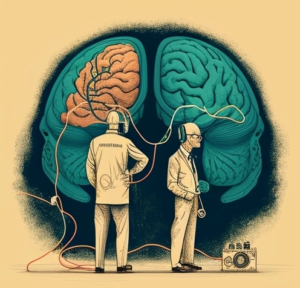
Image: Bango Renders on StockSnap
By Mariana Meneses
Have you ever wondered what is happening in someone’s mind when they hear music, look at a painting, or read a book?
The human brain is the most complex and fascinating organ in the body, capable of processing vast amounts of information every second.
For decades, scientists have been trying to unlock its secrets, and recent advances in neuroscience are bringing us closer to understanding how the physical processes in our brains deliver the subjective experiences of our lives. By observing the activity in people’s brains and analyzing the data with sophisticated algorithms, neuroscientists are mapping the networks that underlie our thoughts, feelings, and behaviors.
Brain researchers often use brain imaging techniques such as functional magnetic resonance imaging (fMRI), which detects changes in blood flow and oxygen consumption, as proxies for measuring the results of neural activity.
For example, by asking people to perform tasks or respond to stimuli while inside an fMRI scanner, scientists can identify the brain regions and networks that are involved in different cognitive processes, such as language comprehension, emotional regulation, decision-making, and memory retrieval.
A 2022 study by Dr. Masahide Yuasa, from the Shonan Institute of Technology in Japan, and co-authors, used fMRI to investigate the neural basis of conversational turn-taking, which is the ability to alternate between speaking and listening in a fluid and cooperative manner. The researchers found that the brain regions responsible for generating speech and monitoring the partner’s spoken responses are tightly connected.
Their results highlighted the role of turn-taking in social relationships, which gives space for mutual understanding and empathy.

Dr. Avniel Ghuman. Image: University of Pittsburgh
Although brain imaging techniques have provided a significant amount of insight into the workings of the brain, there are limitations to what can be learned from having individuals remain stationary in a brain scanner for a short period of time.
This reasoning inspired a recently presented study, led by Dr. Avniel Ghuman, director of the Cognitive Neurodynamics Lab of the University of Pittsburgh.
The researchers wanted to investigate the brain’s activity over a more extended period, so they conducted an experiment that enabled them to monitor activity for about a week. To “listen” to people’s brains, the scientists used data from electrodes implanted in the brains of epilepsy patients prior to surgery, which pinpoint the affected area of the brain for removal. As featured in another The Quantum Record article, epilepsy patients often have electrodes implanted into their brains for treatment.

“It’s a bit like shaking a snow globe—you introduce some random variation and trust that if it goes through a bunch of configurations, the optimal one will pop out somehow,” comments Dr. Rick Adams, a psychiatrist and neuroscientist at the University College London who was not part of the study. Image: Circe DenyerCirce Denyer.
During the week-long observation of brain activity, the research team uncovered unexpected patterns.
They observed distinct brain networks appearing to interact with each other in a choreographed manner, with one region seemingly “listening” while another was “speaking.” The brains switched between different activity patterns over time, but in a peculiar way. Rather than moving smoothly from one pattern to the next, the brains appeared to move chaotically through several intermediate stages. This disorderly behavior was observed as the brain transitioned between different semi-stable states.
The study suggested that our brains need to function in a state between order and disorder to help comprehend the world around us. When we switch activities, like changing from reading a book to talking with a friend, our brains move from one somewhat steady state to another, but not before passing through several other states in a seemingly arbitrary pattern.

Neuralink HQ. Will companies have our brains in their hands? Image: Steve Jurvetson
A prominent recent development in neurotechnology has been delivered by Neuralink, a company controlled by Elon Musk.
Neuralink was founded in 2016, aiming to develop chips that can assist patients in medical treatments. The company is constructing a brain chip interface to be implanted in the skull. Their stated goal is to develop ultra-advanced brain-machine interfaces that could, among other uses, restore vision and aid individuals with disabilities or traumatic injuries in moving, communicating, and operating phones and other devices.
Looking ahead, Neuralink envisions more futuristic applications, including “eventually to expand how we interact with each other and experience the world around us,” by integration with artificial intelligence.
The core technology of Neuralink revolves around the creation of an implantable device capable of transmitting high-bandwidth electrical signals between the brain and a machine. This is achieved through thin, flexible electrodes that can monitor neural activity with remarkable precision. After receiving regulatory approval in 2023 to test the technology on humans, Elon Musk announced that the first human received a brain implant from Neuralink in January 2024. The patient who received the initial implant is reportedly recovering well, and early results show promising detection of neuronal spikes, which are signals of brain activity.
The procedure was announced in a tweet by Musk, but weeks later Neuralink had not disclosed the purpose of the trial, which was not registered with the U.S. government’s clinical trials repository.
The study conducted by Neuralink utilized a robot to introduce a brain-computer interface (BCI) implant through a surgical procedure. It is believed the device was installed in a region of the brain that controls the intention of movement, to test the patient’s ability to control a computer cursor and keyboard by thought alone. Separately, Musk announced that Neuralink’s first product will be called Telepathy.
Despite its technological potential, Neuralink faces a series of technical, ethical, and regulatory challenges, and faces strong competition.
The safety of brain implants is a primary concern, as well as the ethical implications of altering human mental capabilities. Moreover, the regulation of such technologies is currently in uncharted territory, with no generally accepted frameworks to guide development and protect patient health and privacy. Only time will tell the effects of Neuralink-like technology on our future.

Image generated using Midjourney AI
While techniques like brain-computer interfaces can provide valuable insights into human cognition and behavior, they also raise questions about the ownership and confidentiality of personal data, as well as the potential for misuse or abuse of the technology.
For instance, could these techniques be used to infer a person’s thoughts or intentions without their consent, or to discriminate against certain groups based on their brain characteristics?
To address these issues, neuroethicists and policy makers have called for a framework of principles and guidelines that balance individual rights with societal benefits, and promote transparency, accountability, and inclusivity. That is the objective behind the OECD Recommendation on Responsible Innovation in Neurotechnology, a set of guidelines for the responsible conduct of brain research which emphasizes the importance of informed consent, data protection, risk assessment, and stakeholder engagement.
Despite the limitations, the potential benefits of brain studies like these are vast.
Neuroscience has the potential to transform fields such as psychiatry, psychology, education, and marketing, and to improve our understanding of human cognition and behavior. In doing so, we can develop more effective treatments for mental health disorders, improve educational practices, among many other applications.
By using cutting-edge tools and techniques and by adopting ethical and responsible practices, we can observe and understand the neural activity that underlies our experiences and behaviors, unlocking some of the secrets of the mind. As some argue, the brain could be seen as the final frontier of biological exploration, having one of the most intricate and complex systems in the known universe. And we are only at the beginning of this exciting journey.
Craving more information? Check out these recommended TQR articles:
- Where Do I End and Where Does the Machine Begin?
- Update on Global AI Regulations: With Great Power Comes Great Responsibility
- Quantum Sensing’s Revolutionary Potential for Cancer Treatment, Navigation, and Precision Measurement
- Emerging Issues in Space Governance Urgently Require International Agreement
- Searching for Aliens: Scientific Rigor in the Pursuit of Extraterrestrial Life
- Remembering or Forgetting? Quantum Computing May Need Both
- Is This Alien Technology? Test Demonstrates Potential Use of Black Holes to Power Advanced Civilizations.



